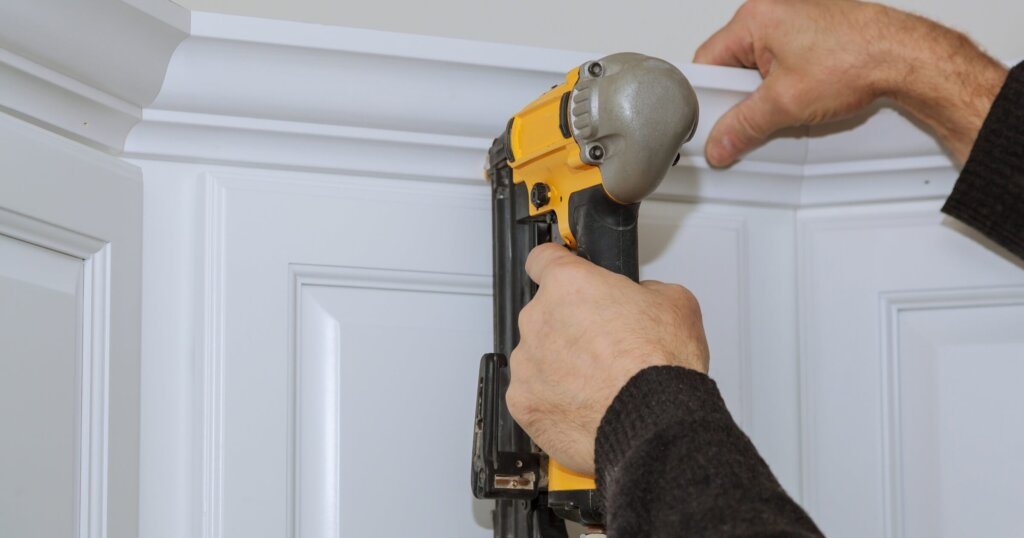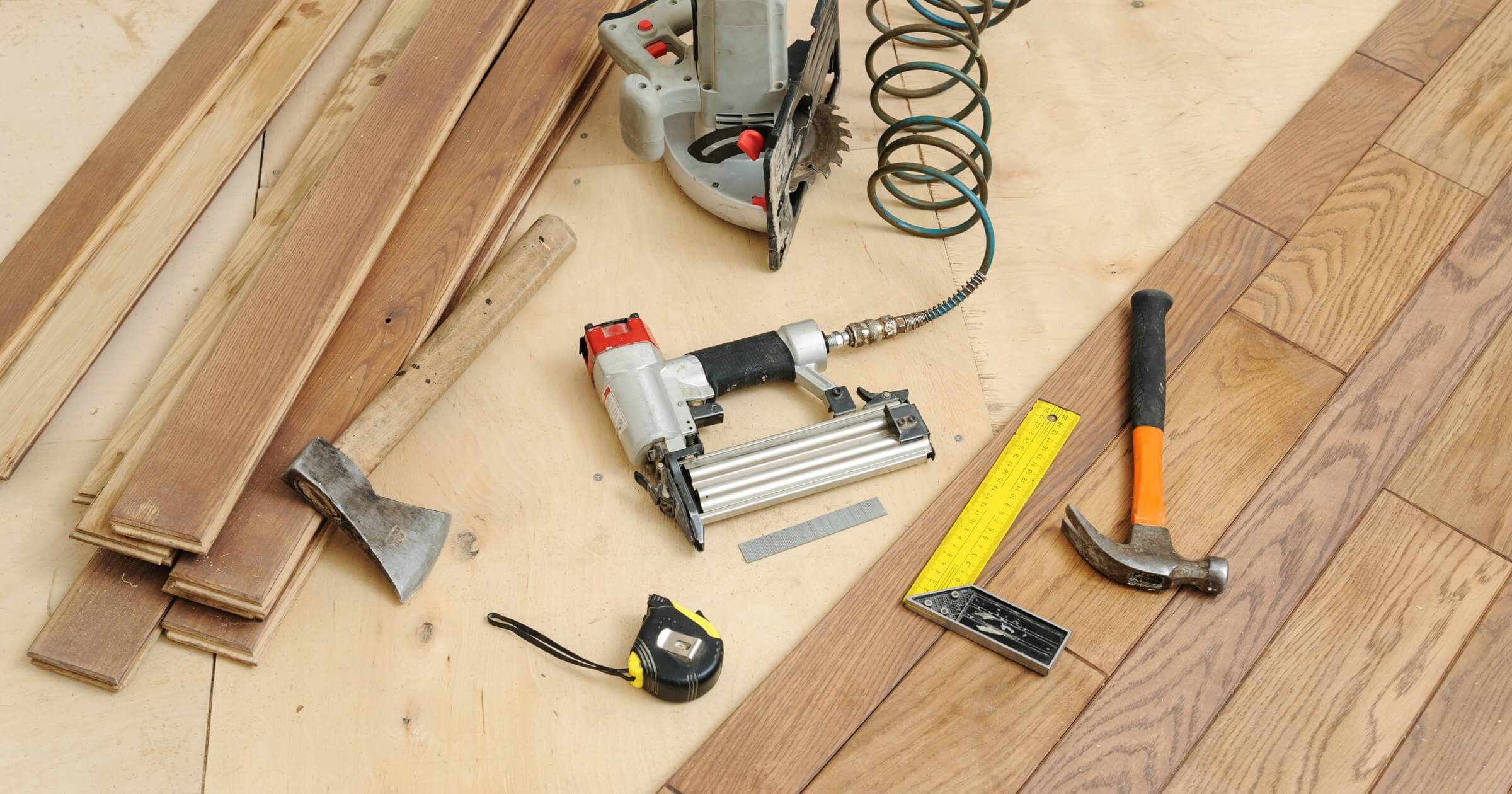If you’re trimming out windows, installing crown molding, or locking in detailed woodwork, having the right nail gun makes a big difference. A finish nailer hits harder and holds firm but can leave larger marks. A brad nailer is more subtle and great for baseboards or lighter trims. Then there’s the pin nailer, which is perfect when you don’t want to see the nail at all. In this article we compare finish nailers vs brad nailers vs pin nailers so you know how to decide which nailer belongs in your tool bag.

Image sourced from Shutterstock
Finish vs brad vs pin nailers compared
Finish nailers
Gauge size: 15 or 16 gauge
Nail length: Usually 1″ to 2.5″
Best for: Finish nailers pack a punch. You reach for them when securing thicker trim, wide baseboards, door casings, or even small crown molding. The nails are long and sturdy, which makes them ideal for holding denser materials in place. Because they’re heavier duty, they work well on MDF, hardwoods, and painted trim that will be caulked or filled later. You’ll often see these on final-stage carpentry jobs. If you’re hanging solid wood door jambs, this is the nailer you want in your hand.
Brad nailers
Gauge size: 18 gauge
Nail length: Usually 5/8″ to 2″
Best for: Brad nailers are the go-to for lighter trim work. They offer a strong enough hold for baseboards, quarter-rounds, and window or door trim. The smaller gauge means less surface damage, so there’s less filling or sanding after. They’re a solid choice for projects using pine, poplar, or other softwoods. For DIYers, finish carpenters, and anyone who cares about aesthetics, Brad Nailers strikes the balance between power and subtlety. Just don’t expect them to hold up heavy wood on their own.
Pin nailers
Gauge size: 23 gauge
Nail length: Usually 3/8″ to 1-3/8″
Best for:
Pin nailers are all about precision. They’re great for delicate work like small trim pieces, beading, or holding joints together while the glue dries. The pins are so fine, they often don’t need filling, which is a huge plus when working with stain-grade wood. These tools are perfect for cabinetry, picture frames, and trim that would split with thicker nails. That said, pins have almost zero holding power on their own so you’ll need glue or another fastener for structural stability.
Nailer comparison chart
How to choose the best nailer for your purpose
Project type and material
The type of project you are tackling will determine what tool would be best. Heavy door trim and MDF call for a finish nailer with strong hold. For medium-duty jobs like installing panel molding or light trim, a brad nailer will keep things secure without damaging the surface. A pin nailer will do the trick without leaving marks if you’re working on decorative pieces, soft trim, or glued joints.
Desired finish quality
If the goal is a clean look with minor patching, go with a pin or brad nailer. Pin nails are almost invisible, and brads leave minimal holes. Finish nails will need more touch-up work, but they’re worth it when you need a tight grip on large moldings.
Budget considerations
Brad nailers are often the most affordable all-around option. Finish nailers are more expensive and heavier, especially if you go cordless. Pin nailers usually come into play when you’ve already invested in the other two and want to up your finish game for specialty projects.
Tool weight and maneuverability
A brad or pin nailer is lighter and easier to manage if you’re working overhead or in tight spots. Finish nailers can be bulky and cause fatigue during ceiling trim or long sessions. Cordless models help but add weight.
Surface damage and filling
The finer the nail, the less repair is needed. If you’re working on stain-grade wood where holes show up, pin nails are best. Painted finishes can tolerate brads or finish nails with filler, but the extra steps add time.
Expert tips for optimal use
Using finish nailers
- Always hold the tool flush to the surface and angle the nail to avoid splitting.
- For door and window trim, sink the nail at two opposing angles to improve grip.
- Use longer nails for thicker material—at least 2″.
- Keep a nail set handy to drive the heads below the surface if your nailer doesn’t countersink well.
- Avoid using delicate trim where cracking is a risk.
Using brad nailers
- Brad nailers work best with light to medium trim.
- Add wood glue when possible for extra strength if you think it may not hold long term.
- If you’re working with MDF or soft pine, brads help avoid the blowout that finish nails might cause.
Using pin nailers
- Pin nails have no head, so it’s best to pair them with glue.
- When firing into softwood, test depth on scrap first as some models overdrive and sink pins too deep.
- Pin nailers are extremely quiet and have little kick so it’s easy to get complacent. Make sure to wear safety glasses and keep fingers clear of the nose.
General safety and maintenance tips
- Always wear eye protection.
- Keep the nose and magazine clean to avoid jams.
- Drain your compressor tank regularly to prevent moisture damage.
- Store cordless models with batteries removed.
- Use the correct gauge nails for your tool to avoid malfunction.
- Periodically, oil pneumatic tools to extend their life.
Each nailer has a clear purpose. Before buying one think about the material you’ll be working with, how much holding power you need, and how clean the finish should be.
Want more tool breakdowns and jobsite tips delivered right to your inbox? Subscribe to our newsletter here and stay sharp with content built for tradespeople who care about their craft.



